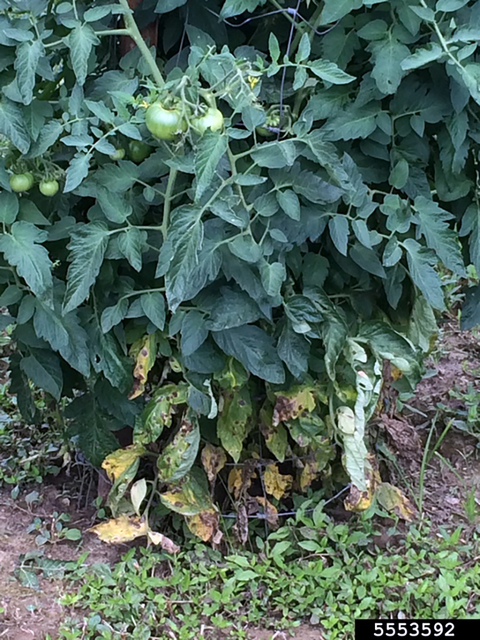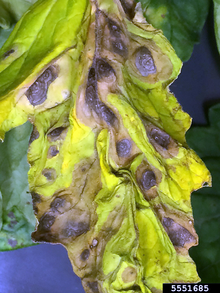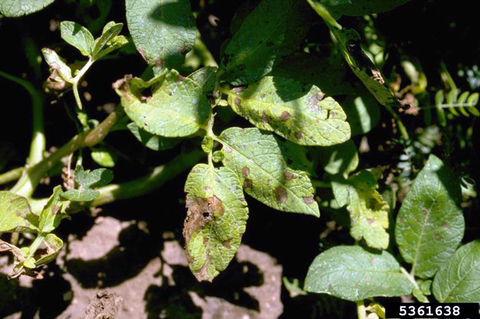Quick facts
- Early blight is one of the most common tomato and potato diseases, occurring nearly every season in Minnesota.
- It affects leaves, fruits and stems and can be severely yield-limiting when susceptible tomato cultivars are used and weather is favorable.
- Severe defoliation can occur. In tomatoes, fruit can be damaged by sun.
Identification
- Initially, small dark spots form on older foliage near the ground. Leaf spots are round, brown and can grow up to 1/2 inch in diameter.
- Larger spots have target-like concentric rings. The tissue around spots often turns yellow.
- Severely infected leaves turn brown and fall off, or dead, dried leaves may cling to the stem.
- Seedling stems are infected at or just above the soil line. The stem turns brown, sunken and dry (collar rot). If the infection girdles the stem, the seedling wilts and dies.
- Stem infections on older plants are oval to irregular, dry brown areas with dark brown concentric rings.
- Fruit can be infected at any stage of maturity.
- Fruit spots are leathery and black, with raised concentric ridges. They generally occur near the stem. Infected fruit may drop from the plant.
Biology
- Early blight can be caused by two closely related species: Alternaria tomatophila and Alternaria solani.
- Both pathogens can infect tomatoes, potatoes, peppers, and several weeds in the Solanaceae family including black nightshade (Solanum ptycanthum), and hairy nightshade (Solanum physalifolium).
- Disease develops at moderate to warm (59 to 80 F) temperatures; 82 to 86 F is its optimum temperature range.
- The pathogen is most likely to spread with wet weather or heavy dew, or when relative humidity is 90% or greater.
- The early blight pathogens both overwinter in infected plant debris and soil in Minnesota. The pathogen also survives on tomato seed or may be introduced on tomato transplants.
- Lower leaves become infected when they come into contact with contaminated soil, either through direct contact or when raindrops splash soil onto the leaves.
- Spores (reproductive structures) can germinate between 47° and 90° F and need free water or relative humidity of 90% or greater.
- Spores infect plants and form leaf spots as small as 1/8 inch in diameter in as little as five days.
- Spores can be spread throughout a field by wind, human contact or equipment, resulting in many reinfection opportunities throughout a growing season.
Managing early blight in the home garden
Resistant varieties
Early blight-resistant varieties are readily available. As early blight occurs commonly in Minnesota, gardeners should look into these varieties.
Resistance does not mean you will not see any early blight; rather, resistant varieties can better tolerate the pathogens, and so the damage will be less severe than with non-resistant varieties.
Cornell University keeps track of varieties sold as having disease resistance. You can often find this information in seed catalogs.
Cultural controls
- Cover the soil under the plants with mulch, such as fabric, straw, plastic mulch, or dried leaves.
- Water at the base of each plant, using drip irrigation, a soaker hose, or careful hand watering.
- Increase airflow by staking or trellising, removing weeds, and spacing plants adequately apart
- Pruning the bottom leaves can also prevent early blight spores from splashing up from the soil onto leaves.
- Let two years pass before you plant tomatoes or peppers in the same location.
Physical controls
- Remove leaves with leaf spots and bury or burn them. You may opt to bury them in your home compost pile if you maintain your compost pile according to Composting in home gardens.
- If you touch infected leaves, wash your hands well before working in healthy tomato plants. If you use pruning tools, wash and sanitize them after touching infected plants.
- It is okay to remove up to one-third of the plant's leaves if you catch the disease early. Do not remove more than one-third of the plant's leaves.
- Keep leaves dry to reduce the spreading of disease.
Fungicides
Most home gardeners don’t need to treat tomatoes with a fungicide. Tomato plants can tolerate a lot of early blight without reducing the number of tomatoes they produce.
Managing early blight on farms
Early blight typically appears in Minnesota in mid to late June. The exact timing varies from year to year, so scout regularly in order to begin managing the disease as soon as it appears.
- There are many resistant tomato cultivars available, often designated with an "EB" in seed catalogs.
- There is an extensive list of resistant cultivars on Cornell University's vegetable pathology website.
- Resistant varieties are not immune to early blight. However, infection will be less severe on either the leaves, stem or both.
- Use pathogen-free seed, or collect seed only from disease-free plants.
- Rotate out of tomatoes and related crops for at least two years.
- Control susceptible weeds such as black nightshade and hairy nightshade, and volunteer tomato plants throughout the rotation.
- Fertilize properly to maintain vigorous plant growth. Do not over-fertilize with potassium and maintain adequate levels of both nitrogen and phosphorus.
- Avoid working in plants when they are wet from rain, irrigation, or dew. Use drip irrigation instead of overhead irrigation to keep foliage dry.
- Stake or trellis and prune the plants to increase airflow around the plant and facilitate drying. Staking will also reduce contact between the leaves and spore-contaminated soil.
- Carefully prune infected leaves, take care to wash and sanitize tools as you prune, and dispose of infected leaves far away from your tomato production areas.
- Apply plastic or organic mulch to provide a barrier between contaminated soil and leaves.
- In the fall, remove or bury infected plants to reduce the likelihood of the pathogen surviving into the following year.
- For greenhouse production, early blight has been reduced by as much as 50% by covering houses with UV-absorbing vinyl film.
Applications should be made when environmental conditions favor disease to be the most effective and repeated according to label instructions. Once the pathogen appears, keep track of forecasts and plan applications accordingly.
It is important to alternate between different chemical families to avoid the development of pathogen insensitivity to particular active ingredients. Some insensitivity to the chemical family 11 has become more common in some areas, so particular care should be taken to rotate these with other chemical families. Also, if insensitivity is already present in a given field population of early blight, fungicides in chemical family 11 will not provide good control.
See the Midwest Vegetable Production Guide for current recommendations.
CAUTION: Mention of a pesticide or use of a pesticide label is for educational purposes only. Always follow the pesticide label directions attached to the pesticide container you are using. Be sure that the plant you wish to treat is listed on the label of the pesticide you intend to use. And observe the number of days between pesticide application and when you can harvest your crop. Remember, the label is the law.
Reviewed in 2024





